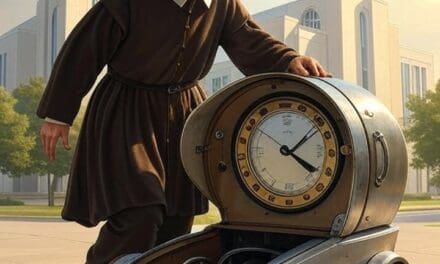Latter-day Saint (LDS) apologists have developed a variety of arguments to defend the truthfulness of the Book of Mormon and the Restoration of the Gospel, emphasizing both internal textual evidence and external corroborations, as well as spiritual confirmation. Below are some of the strongest and most commonly cited arguments, as articulated by prominent LDS apologists such as Hugh Nibley, Daniel C. Peterson, John W. Welch, and organizations like FAIR (now FairLatterDaySaints) and the Neal A. Maxwell Institute. These arguments are considered “hard to refute” by proponents because they often rely on complexity, unique perspectives, or an appeal to faith that transcends empirical critique.
Arguments for the Truthfulness of the Book of Mormon
-
Complexity and Consistency of the Text
-
Argument: The Book of Mormon is a highly intricate narrative with over 500 pages, containing detailed genealogies, geographic descriptions, and a consistent chronological framework spanning roughly 1,000 years. Apologists argue that it is implausible for an uneducated 23-year-old farmer like Joseph Smith, with limited formal schooling, to produce such a sophisticated work in approximately 60-90 days without extensive revisions or notes.
-
Details: The text includes hundreds of named characters, interwoven storylines (e.g., the Nephite and Lamanite conflicts), and a coherent theological structure. Scholars like John W. Welch point to its narrative unity as evidence of divine inspiration rather than human fabrication.
-
Why It’s Hard to Refute: Critics must explain how someone with Joseph Smith’s background could create a text of this depth and consistency under such constraints, especially without apparent literary training or access to extensive resources in 1820s rural New York.
-
-
Chiasmus as Evidence of Ancient Origins
-
Argument: The Book of Mormon contains examples of chiasmus, a sophisticated literary structure common in ancient Hebrew texts (e.g., the Bible), where ideas are presented in a mirrored, repetitive pattern (A-B-C-C-B-A). Apologists, notably John W. Welch, argue that this feature suggests an ancient Semitic origin, as chiasmus was largely unknown in 19th-century America and not something Joseph Smith would likely have encountered.
-
Details: Examples include Alma 36, where the chapter is structured chiastically around the theme of repentance and redemption. Welch contends that the precision of these patterns is unlikely to be accidental or a product of modern composition.
-
Why It’s Hard to Refute: Critics must demonstrate either that Joseph Smith had access to obscure knowledge of Hebrew literary forms (unlikely given his education) or that the presence of chiasmus is coincidental, which becomes statistically challenging given its frequency and complexity.
-
-
Witnesses to the Gold Plates
-
Argument: The testimonies of the Three Witnesses (Oliver Cowdery, David Whitmer, Martin Harris) and the Eight Witnesses provide firsthand accounts of seeing and handling the gold plates from which the Book of Mormon was purportedly translated. Apologists emphasize that these men never recanted their statements, even after some became estranged from Joseph Smith or the Church.
-
Details: The Three Witnesses claimed to have seen an angel along with the plates, while the Eight Witnesses handled them. Their consistent testimonies, despite personal conflicts with Smith, are cited as compelling evidence of the plates’ reality.
-
Why It’s Hard to Refute: Critics must argue that all eleven witnesses were either deceived, colluded in a hoax, or hallucinated, which is difficult to sustain given their diverse backgrounds, the lack of material gain, and their steadfastness over decades.
-
-
Stylometric Evidence of Multiple Authorship
-
Argument: Statistical wordprint analyses (stylometry) suggest that the Book of Mormon reflects multiple distinct authorial voices, consistent with its claim to be a compilation of writings by various ancient prophets (e.g., Nephi, Alma, Mormon). Apologists like those at the Maxwell Institute argue this undermines the theory that Joseph Smith alone authored it.
-
Details: Studies by researchers such as John Hilton and Wayne Larsen identify unique linguistic patterns for different narrators, distinct from Joseph Smith’s known writings (e.g., Doctrine and Covenants).
-
Why It’s Hard to Refute: Critics must explain how an uneducated individual could mimic multiple writing styles unconsciously or why collaborators (if posited) left no trace of their involvement.
-
-
Parallels with Ancient Near Eastern Culture
-
Argument: Hugh Nibley and others highlight parallels between the Book of Mormon and ancient Near Eastern customs, suggesting a historical basis. Examples include the use of “reformed Egyptian” (akin to shorthand scripts), the practice of writing on metal plates (evidenced by discoveries like the Dead Sea Scrolls’ Copper Scroll), and specific legal and covenantal patterns reflective of ancient Israel.
-
Details: Nephi’s journey from Jerusalem, the use of the term “land of Jerusalem” (supported by later archaeological finds like the Amarna Letters), and the coronation ceremony in Mosiah 2-5 (mirroring ancient king-making rituals) are cited as examples.
-
Why It’s Hard to Refute: Critics must dismiss these parallels as coincidental or argue that Joseph Smith had access to obscure scholarly knowledge, which is improbable given the limited availability of such information in 1820s America.
-
Arguments for the Restoration of the Gospel
-
Fulfillment of Biblical Prophecies
-
Argument: LDS apologists assert that the Restoration fulfills biblical prophecies about a latter-day gathering and renewal of God’s covenant people. Passages like Ezekiel 37:16-19 (the “sticks” of Judah and Joseph uniting) and Isaiah 29:4-18 (a sealed book speaking from the dust) are interpreted as referring to the Book of Mormon and the re-establishment of Christ’s Church.
-
Details: The “stick of Joseph” is identified as the Book of Mormon, complementing the Bible (Judah), while the Restoration is seen as the “marvelous work and a wonder” foretold by Isaiah.
-
Why It’s Hard to Refute: Critics must offer alternative interpretations of these verses that exclude the LDS narrative, which often requires rejecting the specificity of the prophecies or their applicability to a modern context.
-
-
Apostasy and the Need for Restoration
-
Argument: Apologists argue that the Great Apostasy— a loss of priesthood authority and doctrinal purity after the death of the original apostles—necessitated a divine restoration. Historical evidence of early Christian doctrinal disputes, the rise of councils to define orthodoxy, and changes in practices (e.g., infant baptism) are cited as proof of this falling away.
-
Details: Daniel C. Peterson and others point to New Testament warnings (e.g., 2 Thessalonians 2:3, Acts 20:29-30) and the absence of apostolic succession in most Christian traditions as evidence that authority was lost, requiring Joseph Smith’s prophetic call.
-
Why It’s Hard to Refute: Critics must either deny the apostasy occurred (contradicting historical shifts in Christianity) or argue that authority persisted unbroken, which is contested by the diversity of modern Christian denominations.
-
-
First Vision as a Divine Event
-
Argument: Joseph Smith’s First Vision in 1820, where he claimed to see God the Father and Jesus Christ, is presented as direct evidence of the Restoration’s divine origin. Apologists emphasize its theological coherence (a physical Godhead) and its alignment with biblical theophanies (e.g., Stephen’s vision in Acts 7:55-56).
-
Details: The vision’s multiple accounts are defended as consistent in core details, with variations attributed to differing audiences or contexts, not contradiction.
-
Why It’s Hard to Refute: Critics must discredit the vision as a fabrication or hallucination, but the sincerity of Smith’s lifelong commitment and the lack of psychological evidence for delusion make this challenging.
-
-
Priesthood Authority and Ordinances
-
Argument: The restoration of priesthood authority through angelic visitations (e.g., John the Baptist conferring the Aaronic Priesthood, Peter, James, and John conferring the Melchizedek Priesthood) is cited as evidence of divine re-establishment. Apologists argue that this authority enables ordinances like baptism and temple rites, absent in other churches.
-
Details: The continuity of these events with biblical precedent (e.g., Moses receiving authority) and their centrality to LDS practice bolster the claim.
-
Why It’s Hard to Refute: Critics must either reject the supernatural claims outright or argue that such authority never lapsed, which conflicts with historical gaps in ordination practices.
-
-
Spiritual Confirmation (Moroni’s Promise)
-
Argument: The ultimate proof, according to apologists like Jeffrey R. Holland, is the personal testimony gained through prayer, as promised in Moroni 10:4-5. Millions of Latter-day Saints claim this witness, asserting that the Holy Ghost confirms the truth of the Book of Mormon and the Restoration.
-
Details: This experiential evidence is framed as superior to intellectual arguments, aligning with biblical calls to seek divine knowledge (James 1:5).
-
Why It’s Hard to Refute: Subjective spiritual experiences are inherently personal and resist external falsification, making them a resilient defense for believers.
-






